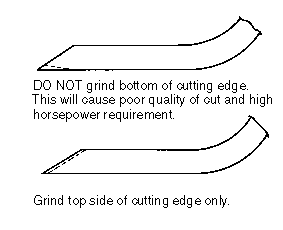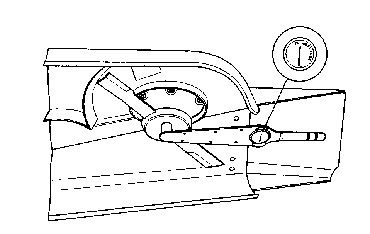Rotary mowers cut grass by the blade cutting surface impacting against the grass stems at a high velocity. To assure good quality of cut, the cutting edge of the blade must be kept in a sharp condition. A dull blade will produce a ragged cut and will require an excessive amount of engine horsepower to rotate the blade through the grass. The most common causes for rotary mowers not giving a good quality of cut are due to dull cutting edges and/or bent blades.
Whenever a blade is removed for sharpening:
WARNING
If blade is allowed to wear, a slot will form between the sail and flat part of the blade. Eventually a piece of the sail may break off and be thrown from under the housing, possibly resulting in serious injury to yourself or a bystander.
Sharpening Process
Before sharpening the blade, check to make sure it is straight. Lay the blade on a flat surface to check.
CAUTION
Do not try to straighten a blade that is bent, and never weld a broken or cracked blade. Always use a new TORO blade to assure continued safety certification of the product.
When sharpening the blade, grind the top surface only, trying to maintain the angle of the original cutting edge. Do not grind the bottom surface or a chisel shape will result. The lowest portion on the blade that contacts the grass must be the cutting edge or the grass will not be cleanly cut and excessive horsepower will be required.
WARNING

To prevent possible personal injury, wear a face shield or safety glasses when grinding or sharpening is being done.
After the blade has been sharpened, check the balance. This can best be done by using a blade balancer tool. A balanced blade will stay in a horizontal position on the balancer. A blade that is not balanced will settle to the heavy side. If the blade is not balanced, grind some metal off the heavy end of the blade. DO NOT grind bottom of cutting edge. This will cause poor quality of cut and high horsepower requirement.
Blade Bolt Torque

When installing blades, be sure to tighten the blade retaining bolt to the proper torque. Do not use an air or electric wrench to apply the final torque. To prevent loosening or damaged threads, always use a standard torque wrench to apply the final torque.
Check blade retaining bolt torque any time a blade has hit a solid object.